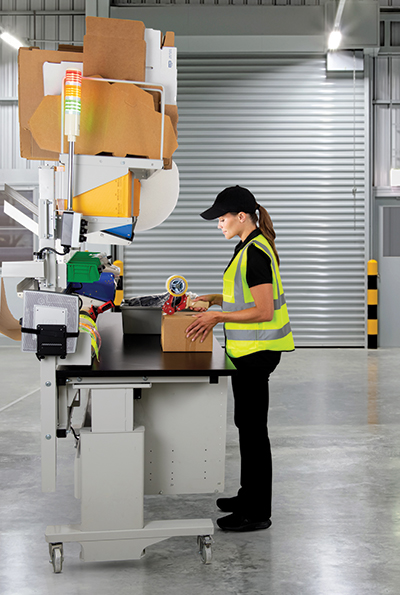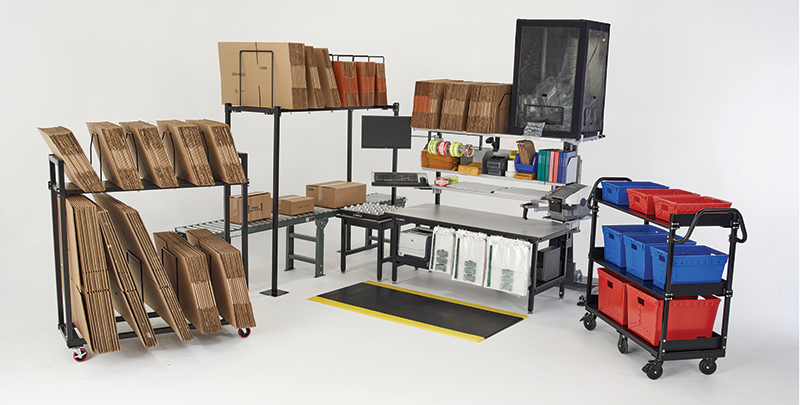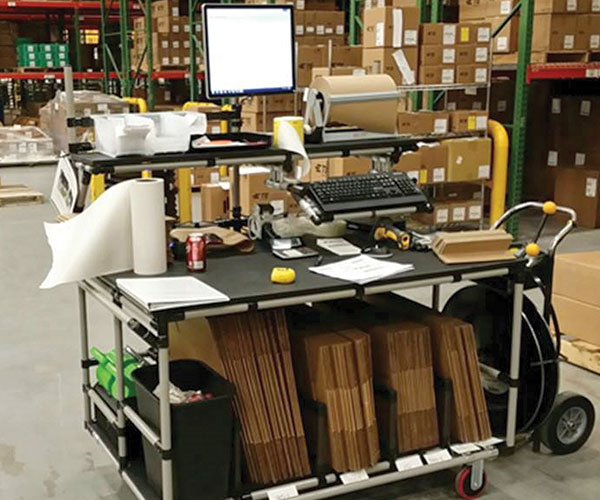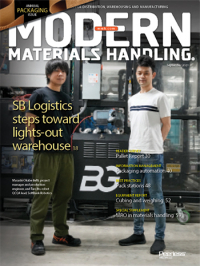Efficient packing is forward facing packing
Packing stations must meet the demands of labor shortages, faster pacing and more demanding customers. Here’s how they do it.
As it looked back over its lost-time claims from a two-year period, a national outdoors apparel retailer came to an eye-opening conclusion: a full 70% of those claims fell into the work-related musculoskeletal disorders (WMSD) category. And most of those WMSDs occurred due to issues at the packing stations within the distribution center.
Packing stations are one of the busiest areas of warehouses these days and employees find themselves under pressure to move items out the door quickly and efficiently. When designed well, the employees pull this off not only seamlessly, but without any wear and tear on their bodies. But to get to that sweet spot, companies must first assemble packing stations that meet all the requirements for efficient, ergonomics-forward operations.
In the case of this outdoor apparel retailer, that meant assembling a team of engineers, maintenance staff, an ergonomics specialist and an occupational health nurse to analyze the situation. The team identified issues like excessive repetitions, incorrect workstation height, and incorrect tool angles. Partnering with BOSTONtec, the team created workstations that reduced lost time from musculoskeletal issues by 79%.
The redesign included new stations with high-use items ideally located within the primary zone, medium use items in the secondary zone, and seldom accessed items in the furthest zone or storage area. They also added electric height adjustable tables, allowing each operator to set up their work areas to an ideal height and position.
Collaborative partnerships like this are increasingly becoming the name of the game when it comes to setting up the ideal packing station, says Jeff Dehnert, president of Dehnco. “Customers used to think of us as a vendor only,” Dehnert explains. “Now they treat us like a partner, and we work together to solve the obstacles and issues they have. It leads to new solutions and successes for growing a business cost effectively.”
Nina Neuschuetz of BOSTONtec adds: “Our engineers work with our customers to design the right solution for their particular needs.”
Packing stations are the object of a good deal of attention and investment these days, and for good reason.
What to consider
 Once you have the role of the packing station identified, it’s time to focus on the station’s design and what equipment is needed for optimal efficiency.
Once you have the role of the packing station identified, it’s time to focus on the station’s design and what equipment is needed for optimal efficiency.
Dehnert says this is most often achieved when taking a holistic approach. “When you think through all of the obstacles first, you can make your stations more cost effective,” he says. “This is particularly true with the e-commerce side of the business.”
The rapid acceleration of e-commerce is a playing a big part in workstation design right now. “Even prior to the pandemic, e-commerce was picking up steam,” says Dehnert. “As it expands, we’re seeing much more specialization of processes, whether single line, multiple line, or the need to group similar sized orders together.”
Kevin Ledversis, director of sales with Newcastle Systems, agrees. “The number of parcels and packages that have to be put together has exploded,” he says. “Companies have to ramp up their facilities to keep up. It impacts everything but packing stations in particular.”
In the current environment, getting the packing station right is critical to overall DC efficiency. To reach that point, several considerations are important to keep in mind, says Neuschuetz of BOSTONtec. “The first thing you must determine is the purpose of the station,” she says. “What is its role within the DC?”
Often, the role of a packing station is far more integrated in overall operations than in the past, when workstations were generally solo islands. If that’s not the case, it’s probably time to retrofit to keep up with modern demands. “Often when companies talk to us about integrating new equipment, it’s part of a tear down, which can make it easier,” says Neuschuetz. “This might also be part of a build out, bringing in a big customer, or adding manufacturing to an existing DC structure.”
Dehnert says that incorporating robotics and other technology into the packing station is becoming the name of the game. “This is something companies are really embracing now,” he explains.

With companies pressed to improve throughput, there’s more emphasis than ever on ergonomic design at the packaging station.
Part of the reason is that many packaging stations these days are highly utilized to process eaches. “You are going to have 75 flavors of phone covers, and your staff will be picking purple 50 times a day, separately,” explains Ledversis. “You can’t waste time with a low-margin item like that—it will kill your profit every time.”
One approach to gaining efficiency in the packing station is to make it mobile, says Ledversis. “Instead of moving everything to the packing station, take the table to where the work is,” he says. “Say you dump five pallets of items on the shipping floor and then bring the station to the items, with everything you need to process and package them. E-commerce is all about speed—if you’re trying to rapidly ship in big piles, things will get messy.”
What does an ideal mobile packing station look like? Often the customer first designs it from a variety of components, customizing it to the shape and size needed, and then adding on wheels. “I’ve seen all sizes and shapes work for different customers,” says Ledversis, whose battery packs often power these mobile units.
Another option is goods-to-person packing stations, says Neuschuetz. “You might see a batch station with a vertical lift integrated in, so that when a tote arrives to an operator, they have somewhere to break it down,” she says. “The labor shortage is partly driving this—you don’t have three or four people picking.”
Instead, she says, the tote goes to the packing station, where one person picks it, breaks it down, repackages it, and readies it to ship. “We’re seeing conveyors bringing products to the tables, pick-to-light integration, scales, screens and anything else at the stations so the worker can stay put and get the job done,” Neuschuetz says.
Packing stations should also incorporate flexibility for materials needed. “You want the ability to switch things up quickly,” says Dehnert. “You might be using paper one day and air pillows the next. The workstation must be able to change designs in this manner in a fast, cost-effective way.”
Neuschuetz also recommends adding in box-building shelves to the station to make it easier and faster to break down and repack boxes for shipping. “You want to be able to keep the table open so there are no obstacles in the way when completing an order,” she says. “Don’t forget to keep all the supplies in stock so that there’s no need to pause operations.”
Ergonomics is front and center
As the labor shortage continues to impact distribution centers, employees are asking for better benefits and higher salaries. But that’s not the only thing on their minds: keeping employees healthy and happy is more important than ever.
Like the BOSTONtec example in the outdoor apparel industry, the right equipment and design can make all the difference here.
“With companies so pressed to improve throughput, there’s more emphasis than ever on ergonomic design at the packaging station,” says Dehnert. “Ergonomics specialists are looking at how employees reach, bend and move overall.”
Companies who leave this out of the equation will find it harder to recruit and retain workers. Also important is to design workstations with flexibility in mind to accommodate all shapes and sizes of employees over the course of multiple shifts.
“If you have someone who is 5 feet tall on one shift, and 6 feet tall on the next, the station must be adjustable to make their jobs easier and more comfortable,” adds Ledversis. “And because they’re standing all day, including anti-fatigue mats, having the screens at the right height, and eliminating footsteps over a shift can make a big difference. Your staff will appreciate it and be more likely to stick around.”
Ledversis adds that having a flexible battery system to power it all through various shifts, and with various items in mind, is important, too. “You want swappable battery systems that are light and ergonomic,” he says. “You don’t want to have to stop work to plug your batteries into a wall.”
For the time being, the rapid pace at the packing station is unlikely to subside, nor is the labor shortage. As demands remain high and the number of employees remain low, companies must work with their packing station partners to design the optimal work spaces. “You have to ramp up operations if you’re going to keep up today,” says Ledversis. “You have to think flexibility, mobility, and best-in-class going forward.”

Article Topics
Packaging News & Resources
Registration open for Pack Expo International 2024 Pack Expo East has largest show to date Optimize Parcel Packing to Reduce Costs CMC Packaging Automation North America unveils Tech Center in Atlanta PACK EXPO East brings latest packaging technologies to Philadelphia Loftware’s cloud-based labeling solutions take center stage Flexcon unveils its innovative bin solutions More PackagingLatest in Materials Handling
Geek+ and System Teknik deploy PopPick solution for pharmacy group Med24.dk Beckhoff USA opens new office in Austin, Texas Manhattan Associates selects TeamViewer as partner for warehouse vision picking ASME Foundation wins grant for technical workforce development The (Not So) Secret Weapons: How Key Cabinets and Asset Management Lockers Are Changing Supply Chain Operations MODEX C-Suite Interview with Harold Vanasse: The perfect blend of automation and sustainability Consultant and industry leader John M. Hill passes on at age 86 More Materials HandlingAbout the Author
Subscribe to Materials Handling Magazine

Find out what the world's most innovative companies are doing to improve productivity in their plants and distribution centers.
Start your FREE subscription today.
April 2024 Modern Materials Handling

Latest Resources












